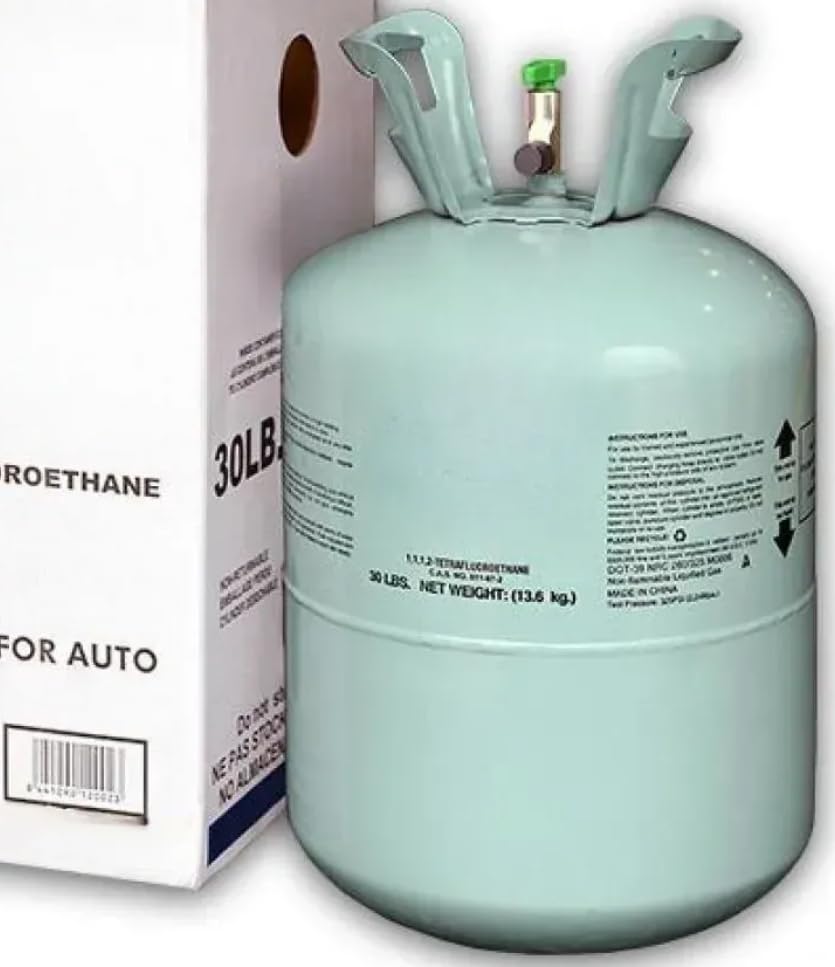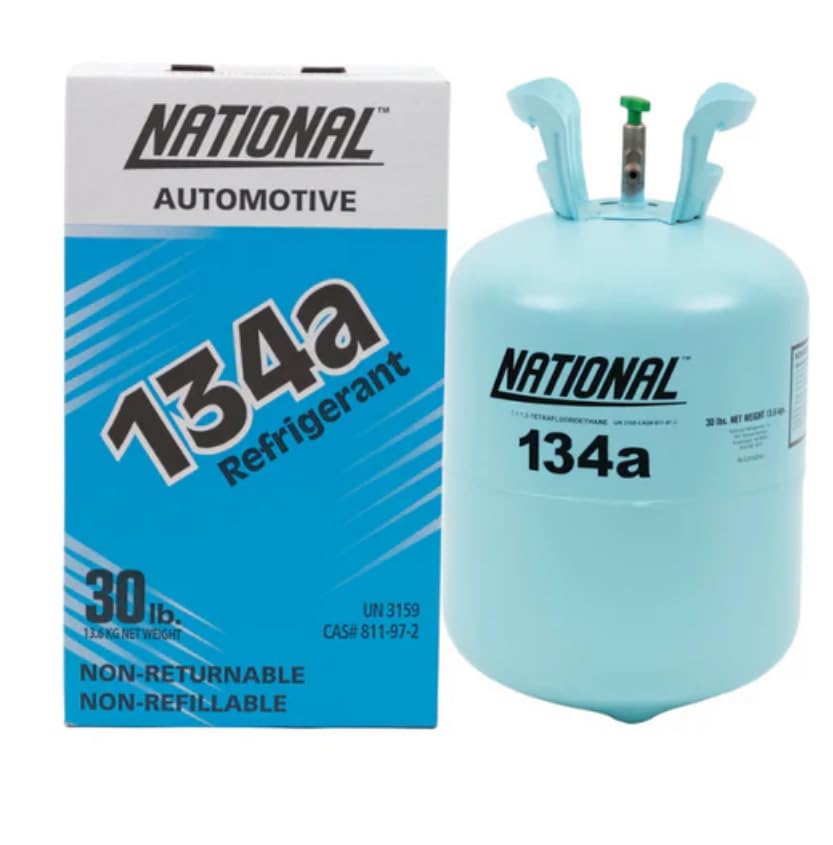In 2025, choosing the right R134A refrigerant can feel like searching for a needle in a haystack. With so many options, how can one find the best fit for their vehicle? Experts have narrowed it down to three top contenders, each bringing unique benefits to the table. From eco-friendly solutions to user-friendly designs, these refrigerants promise effective cooling without the environmental guilt. Want to find out which one suits your needs best? Stay tuned for an in-depth look!
Key Takeaways
- The Chemours Brand R134a is highly rated, ideal for car owners looking for efficient maintenance and quick recharges.
- Industrial Replacement Automotive AC Freon R134A offers universal compatibility and restores original cooling performance effectively, suitable for various vehicles.
- Replacement Compatible Automotive AC R-134a Freon is environmentally friendly and non-ozone depleting, making it a perfect choice for eco-conscious vehicle owners.
- Proper handling and safety precautions are crucial when using R134A to prevent refrigerant leaks and ensure safety during application.
- Performance assurance features in R134A refrigerants ensure effective cooling and compliance with environmental regulations, enhancing overall vehicle reliability.
Industrial Replacement Automotive AC Freon R134A (30 lbs)
- Automotive air conditioning industrial replacement. This is an American 30LBS cylinder made in the USA to make sure vehicle gets back its original cooling. Guaranteed to work and cool down vehicles in need of some A-C. Universal fit for any car or truck with OEM specs of industrial replacement of R134A-30lbs Refrigerent
When it comes to keeping your vehicle’s air conditioning system frosty and efficient, the Industrial Replacement Automotive AC Freon R134A (30 lbs) emerges as a standout choice for car and truck owners alike. This American-made refrigerant is specially designed for universal compatibility with both gas and diesel vehicles needing R134A. It effectively restores original cooling performance, ensuring a comfortable ride even on the hottest days. Plus, it’s packaged in a convenient 30 lbs cylinder, making it easier to handle. Just remember, following safety guidelines is essential when using this product to achieve the best results and keep things cool on the road!
Best For: Vehicle owners looking to efficiently restore their automotive air conditioning performance with a reliable R134A refrigerant.
Pros:
- Universal compatibility with gas and diesel vehicles.
- Restores original cooling performance, ensuring a comfortable driving experience.
- Conveniently packaged in a 30 lbs cylinder for easy handling.
Cons:
- Requires proper handling and attention to safety guidelines during use.
- May not be compatible with vehicles that do not meet OEM specifications for R134A.
- Availability may be limited in certain regions or retailers.
Chemours Brand R134a for MVAC use in a 12-Ounce Self-Sealing Container (2)
The Chemours Brand R134a for MVAC use, packaged in a convenient 12-ounce self-sealing container, stands out as an excellent choice for car owners and DIY enthusiasts alike. This refrigerant, often known as Freon, delivers dependable cooling performance, ensuring your vehicle’s air conditioning runs smoothly. With a solid average rating of 4.6 out of 5 stars from 300 customers, it’s no wonder this product ranks high in its category. Available since May 2020, it continues to meet customer needs, offering a 30-day return policy via Amazon. Whether for maintenance or a quick recharge, Chemours makes handling automotive air conditioning simple and effective.
Best For: Car owners and DIY enthusiasts looking for a reliable refrigerant to maintain or recharge their vehicle’s air conditioning system.
Pros:
- High customer satisfaction with an average rating of 4.6 out of 5 stars.
- Convenient 12-ounce self-sealing container makes usage and storage easy.
- Suitable for both maintenance and quick recharges of automotive air conditioning systems.
Cons:
- Limited to automotive applications, not suitable for home or commercial air conditioning systems.
- Only available in a 12-ounce size, which may not be enough for larger vehicles.
- Potential shipping restrictions due to regulations on refrigerant products.
Replacement Compatible Automotive AC R-134a Freon (30lbs)
- One of the key benefits of This replacement R-134a is that it is a non-ozone depleting refrigerant, which makes it a more environmentally friendly choice than older products which is a chlorofluorocarbon (CFC) that has been phased out due to its harmful effects on the ozone layer.This product is made in the USA by the most sought off AC ref company
For anyone looking to keep their vehicle’s air conditioning running smoothly, the Replacement Compatible Automotive AC R-134a Freon in a 30-pound cylinder stands out as a top choice. Made in the USA, this refrigerant is ideal for both diesel and gas engines, ensuring reliability and performance. Each cylinder arrives full and in perfect condition, providing peace of mind. Unlike older CFCs, it is non-ozone depleting, making it a more environmentally friendly option. With its high-quality manufacturing, this product is sure to meet the demands of any car enthusiast. Keeping cool has never felt this responsible or easy!
Best For: Car owners looking for a reliable and environmentally friendly refrigerant for their automotive air conditioning systems.
Pros:
- Non-ozone depleting refrigerant, making it a safer choice for the environment.
- Manufactured in the USA by a reputable company, ensuring high quality and reliability.
- Suitable for both diesel and gas engines, enhancing versatility in automotive applications.
Cons:
- Availability may be limited in some regions due to shipping restrictions on refrigerants.
- Requires proper handling and equipment for safe usage, potentially limiting DIY options for some users.
- Larger 30-pound cylinder size may be excessive for casual users or those with smaller vehicles.
Factors to Consider When Choosing R134a Refrigerant
When selecting R134a refrigerant, several important factors come into play to guarantee a smooth and efficient vehicle cooling experience. Compatibility with the specific vehicle systems is essential, as not all refrigerants are created equal. Additionally, considerations like packaging size options, environmental safety standards, manufacturer reputation, and performance features can make all the difference in keeping cars cool and drivers happy.
Compatibility With Vehicle Systems
Choosing the right R134A refrigerant for a vehicle is vital, especially since not all air conditioning systems are built the same way. It’s important to verify that the refrigerant is compatible with the vehicle’s A/C system, as using an incompatible type can lead to big headaches—like system damage or poor performance. Always check the manufacturer’s specifications to see if they recommend R134A. The vehicle’s engine type also matters; both gas and diesel engines can work with R134A, but their needs might vary. Finally, don’t forget to take into account the vehicle’s age. Older models may have different refrigerant requirements, making R134A a potential no-go. Choose R134A that meets industry standards to keep the A/C running smoothly and safely.
Packaging Size Options
Selecting the right packaging size for R134A refrigerant is just as important as ensuring compatibility with the vehicle’s A/C system. R134A comes in various sizes, from handy 12-ounce containers perfect for quick repairs to hefty 30-pound cylinders meant for commercial applications or extensive service tasks. Consideration of how often the refrigerant will be used is key; frequent users might find larger sizes more cost-effective since they usually offer a better price per ounce. Additionally, proper handling and storage are essential, especially with bigger containers that require more space. Choosing the right size not only boosts convenience but also keeps you from running to the store mid-project. So, pick wisely and enjoy hassle-free air conditioning!
Environmental Safety Standards
Steering through the world of refrigerants can sometimes feel like deciphering a secret code, especially with environmental safety standards playing an essential role. R134a stands out as a hero among refrigerants because it doesn’t harm the ozone layer, unlike older CFCs. The Environmental Protection Agency (EPA) imposes strict regulations to limit R134a emissions, ensuring that our planet stays healthier. Although R134a has a global warming potential (GWP) of 1430, it’s not quite in the clear, as newer refrigerants are emerging with even lower GWP. To make a positive impact, recycling and proper recovery of R134a are a must. As regions shift toward better options, choosing the right refrigerant isn’t just important—it’s essential for the environment.
Manufacturer Reputation Matters
When diving into the world of R134a refrigerants, a key consideration is the reputation of the manufacturer behind the product. A well-known manufacturer often signifies a strong commitment to quality and safety standards, which can have a significant impact on performance. Established brands generally invest more in research and development, leading to better products. Customer ratings provide insights into reliability; higher ratings are usually a green light for consistent quality. Additionally, a reputable manufacturer is more likely to offer good customer support and solid warranty options, giving consumers peace of mind. Many leading companies also prioritize regulatory compliance and environmental factors, ensuring their refrigerants are safe and eco-friendly. So, choose wisely—your air conditioning deserves the best!
Performance Assurance Features
Choosing the right R134a refrigerant goes beyond simply picking a reputable brand; performance assurance features play a significant role too. These features guarantee that your automotive air conditioning system can restore its original cooling power. Effective R134a options can boost cooling efficiency for both gas and diesel vehicles, making every drive a breeze. Ensuring that all cylinders are filled properly under ideal conditions helps prevent leaks, maximizing cooling output. It’s essential for consumers to seek out refrigerants that highlight high manufacturing quality and solid performance assurances, leading to dependable results. Plus, R134a’s non-ozone depleting properties make it environmentally friendlier than older refrigerants—talk about a win-win! So, choose wisely and enjoy a cool ride!
Proper Handling Guidelines
Proper handling guidelines for R134a refrigerant are vital to guarantee safety and effectiveness during the process. First and foremost, individuals should always wear personal protective equipment, like gloves and goggles, to avoid any skin or eye irritation from the refrigerant. Next, making sure the workspace is well-ventilated is imperative, as refrigerant gas can displace oxygen, leading to asphyxiation risks—an unwanted surprise! Checking for leaks in the system before and after use helps confirm no R134a escapes into the atmosphere. When storing R134a cylinders, keep them upright and secure to prevent any hazardous tipping. Finally, always consult the manufacturer’s safety data sheets for detailed handling and disposal instructions. Remember, safety first—because nobody likes an unexpected refrigerant adventure!
Frequently Asked Questions
What Are the Environmental Impacts of Using R134A Refrigerant?
The environmental impacts of using R134A refrigerant include its contribution to global warming, as it has a high global warming potential. Additionally, its release can affect air quality and pose risks to human health and ecosystems.
Can R134A Be Used in Older Vehicle Models?
R134a can be used in older vehicle models, provided they are compatible. However, modifications may be necessary to accommodate its properties, and users should consider the environmental regulations surrounding refrigerant use in vehicles.
How Do I Safely Handle R134A Refrigerants?
To safely handle R134A refrigerants, one should wear protective gear, work in a well-ventilated area, avoid open flames, and ascertain proper storage. Familiarity with safety data sheets enhances awareness of potential hazards and safe practices.
What Is the Shelf Life of R134A Refrigerants?
R134A refrigerants have a shelf life averaging five years when stored properly. Like a fine wine, their effectiveness can diminish over time, making it essential to check expiration dates before use to guarantee peak performance.
Are There Alternatives to R134A That Are More Eco-Friendly?
Yes, alternatives to R134A that are more eco-friendly include R1234yf and R448A. These refrigerants present lower global warming potential, making them favorable options in pursuing environmental sustainability while maintaining efficient cooling performance.
Conclusion
In conclusion, choosing the right R134A refrigerant can make all the difference in keeping your vehicle cool and efficient. With options like the Industrial Replacement, Chemours Brand, and eco-friendly alternatives, drivers have plenty of fantastic choices. Remember, you don’t want to throw good money after bad, so pick a product that suits your needs. With a little care, you can guarantee your ride stays breezy and pleasant, just like a summer day should be!
Last update on 2025-11-16 / Affiliate links / Images from Amazon Product Advertising API


